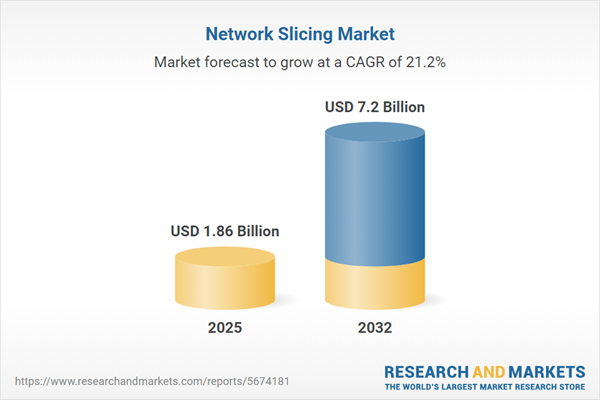Speak directly to the analyst to clarify any post sales queries you may have.
The network slicing market is rapidly evolving as telecom operators and enterprises embrace next-generation connectivity strategies. As digitalization accelerates, network slicing enables tailored services and operational agility, positioning providers to meet the varied demands of modern industries without duplicating physical resources.
Market Snapshot: Network Slicing Market Size and Growth
The network slicing market grew from USD 1.55 billion in 2024 to USD 1.86 billion in 2025 and is on track to achieve a 21.15% CAGR, reaching USD 7.20 billion by 2032.
Growth is fueled by advancements in software-defined networking and 5G, unlocking new business models across sectors. Vendors and solution integrators are shaping a fast-moving landscape, while regional adoption differences reflect local infrastructure, regulatory initiatives, and strategic collaboration among ecosystem players.Scope & Segmentation of the Network Slicing Market
The research provides deep market insights by evaluating technologies, use cases, and organizational needs. Segmentation captures the diversity in solutions and demand:
- Component: Hardware, Consulting, Implementation, Support & Maintenance, Software
- Slice Type: eMBB (enhanced Mobile Broadband), mMTC (massive Machine Type Communication), URLLC (Ultra-Reliable Low Latency Communication)
- Level of Slicing: Horizontal, Vertical
- Deployment Model: Non-Standalone, Standalone
- Organization Size: Large Enterprises, Small & Medium Enterprises
- End User Vertical: Automotive, Healthcare, Manufacturing, Media & Entertainment, Public Safety, Telecom Service Providers, Transportation & Logistics
- Geographic Coverage: Americas (North America: United States, Canada, Mexico; Latin America: Brazil, Argentina, Chile, Colombia, Peru), Europe, Middle East & Africa (including United Kingdom, Germany, France, Russia, Italy, Spain, Netherlands, Sweden, Poland, Switzerland, United Arab Emirates, Saudi Arabia, Qatar, Turkey, Israel, South Africa, Nigeria, Egypt, Kenya), Asia-Pacific (China, India, Japan, Australia, South Korea, Indonesia, Thailand, Malaysia, Singapore, Taiwan)
- Key Companies: Affirmed Networks Inc., Amdocs, Inc., Broadcom, Inc., BT Group PLC, Ciena Corporation, Cisco Systems, Inc., Druid Software Limited, Firecell, Huawei Technologies Co., Ltd., Intel Corporation, Juniper Networks, Inc., Mavenir Systems, Inc., Nanjing ZTE Software Co. Ltd., NEC Corporation, Niral Networks Pvt. Ltd., Nokia Corporation, Parallel Wireless, Inc., Qualcomm Technologies, Inc., Samsung Electronics Co., Ltd., SK Telecom Co., Ltd., SliceFinity Limited, T-Mobile USA, Inc., Tambora Systems Ltd., Telefonaktiebolaget LM Ericsson, VMware, Inc.
Key Takeaways for Strategic Decision-Makers
- Network slicing empowers operators to deliver differentiated service tiers and support enterprise mission-critical applications by leveraging flexible, software-defined architectures.
- Collaboration across vendors, telecom providers, and the cloud ecosystem is essential to create innovative solutions and speed adoption, especially as open-source developments reshape standards and interoperability.
- Emerging application areas, such as smart cities and autonomous vehicles, benefit from regional pilots and strong public-private partnerships, accelerating real-world deployments and vertical-specific innovation.
- Customization capability allows industry players to address bandwidth-intensive, IoT-driven, and ultra-reliable connectivity requirements without extensive new infrastructure.
- Supply chain diversification and a mix of domestic/offshore strategies help manage evolving tariff landscapes and procurement risks, supporting resilience and cost control.
Tariff Impact on Network Slicing Deployment and Supply Chains
Recent United States tariff adjustments on telecommunications components are reshaping global network slicing supply chains. Service providers are reevaluating sourcing choices and cost structures, often blending local and offshore production and pursuing partnerships in favorable trade regions. This environment is fostering innovation in open-architecture and software-driven solutions that minimize dependency on proprietary hardware, enhancing resilience against market volatility.
Methodology & Data Sources for Network Slicing Market Analysis
Research methodology combines primary interviews with telecom operators, solution providers, manufacturers, and end users, along with secondary reviews of technical papers, regulatory filings, and industry case studies. Quantitative and qualitative validations ensure cross-verified, actionable insights, while advisory board input and real-time monitoring capture shifts in standards and innovation trajectories.
Why This Report Matters to Telecom Executives
- Enables risk-informed decision-making by outlining the full value chain, from software advances to regional deployment landscapes.
- Identifies industry trends, tariff implications, and technology drivers influencing future growth and operational efficiency.
- Equips leadership with segmentation analysis and competitor intelligence to guide ecosystem partnerships and go-to-market strategies.
Conclusion
The network slicing market is defining the next era of telecom and digital service differentiation. Decision-makers who act on these insights can align offerings to a dynamic landscape and unlock new opportunities in the global digital economy.
Additional Product Information:
- Purchase of this report includes 1 year online access with quarterly updates.
- This report can be updated on request. Please contact our Customer Experience team using the Ask a Question widget on our website.
Table of Contents
3. Executive Summary
4. Market Overview
7. Cumulative Impact of Artificial Intelligence 2025
Companies Mentioned
The companies profiled in this Network Slicing market report include:- Affirmed Networks Inc.
- Amdocs, Inc.
- Broadcom, Inc.
- BT Group PLC
- Ciena Corporation
- Cisco Systems, Inc.
- Druid Software Limited
- Firecell
- Huawei Technologies Co., Ltd.
- Intel Corporation
- Juniper Networks, Inc.
- Mavenir Systems, Inc.
- Nanjing ZTE Software Co. Ltd.
- NEC Corporation
- Niral Networks Pvt. Ltd.
- Nokia Corporation
- Parallel Wireless, Inc.
- Qualcomm Technologies, Inc.
- Samsung Electronics Co., Ltd.
- SK Telecom Co., Ltd.
- SliceFinity Limited
- T-Mobile USA, Inc.
- Tambora Systems Ltd.
- Telefonaktiebolaget LM Ericsson
- VMware, Inc.
Table Information
| Report Attribute | Details |
|---|---|
| No. of Pages | 184 |
| Published | November 2025 |
| Forecast Period | 2025 - 2032 |
| Estimated Market Value ( USD | $ 1.86 Billion |
| Forecasted Market Value ( USD | $ 7.2 Billion |
| Compound Annual Growth Rate | 21.1% |
| Regions Covered | Global |
| No. of Companies Mentioned | 26 |









